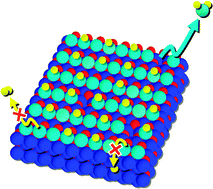Hydrogen reactivity on highly-hydroxylated TiO2(110) surfaces prepared viacarboxylic acid adsorption and photolysis†
Abstract
Combined scanning tunneling

* Corresponding authors
a
Environmental Molecular Science Laboratory and Institute for Integrated Catalysis, Pacific Northwest National Laboratory, Richland, USA
E-mail:
igor.lyubinetsky@pnnl.gov
b
Fundamental & Computational Sciences Directorate and Institute for Integrated Catalysis, Pacific Northwest National Laboratory, Richland, USA
E-mail:
nikolai.petrik@pnnl.gov
c
Department of Chemical Engineering, Worcester Polytechnic Institute, Worcester, USA
E-mail:
nadeskins@wpi.edu
Combined scanning tunneling

 Please wait while we load your content...
Something went wrong. Try again?
Please wait while we load your content...
Something went wrong. Try again?
Y. Du, N. G. Petrik, N. A. Deskins, Z. Wang, M. A. Henderson, G. A. Kimmel and I. Lyubinetsky, Phys. Chem. Chem. Phys., 2012, 14, 3066 DOI: 10.1039/C1CP22515D
To request permission to reproduce material from this article, please go to the Copyright Clearance Center request page.
If you are an author contributing to an RSC publication, you do not need to request permission provided correct acknowledgement is given.
If you are the author of this article, you do not need to request permission to reproduce figures and diagrams provided correct acknowledgement is given. If you want to reproduce the whole article in a third-party publication (excluding your thesis/dissertation for which permission is not required) please go to the Copyright Clearance Center request page.
Read more about how to correctly acknowledge RSC content.
 Fetching data from CrossRef.
Fetching data from CrossRef.
This may take some time to load.
Loading related content
